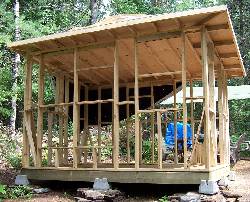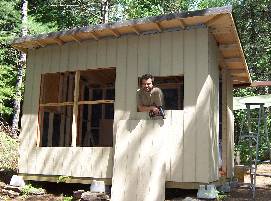
Seeds fermenting in water. Not pretty, but pretty important! The jar got shaken up while walking it outside for its photo op., so it looks a little cloudy and messy. In your jar, you should see a layer of scum on top of the water.
It’s easy to save seed from your favorite tomatoes. Seed saving in general is actually a little tricky. You can’t just save the seed from any old vegetable in your garden and hope that it will yield plants like the parent. Cross-breeding is an issue. Professional seed savers use all sorts of sacks and screens and boxes to ensure that busy bees or flirtatious winds don’t make romance happen where it ought not. Otherwise you get acorn squash crossing with melons and who knows what not. It depends on the type of vegetable you want to save seed from–as well as what else you’re growing around it.
Tomatoes, however, are a pretty safe bet for seed saving. They are self-fertile, and the structure of their flowers makes cross pollination difficult. Our seed saving Bible, Seed to Seed, says that there are only three types of open pollinated tomatoes that you can’t save seed from (without putting them in isolation):
- Currant tomatoes (L. pimpinellifolium)
- The potato leaved varieties of L. lycopersicum
- Any fruit born from double blossoms on Beefsteak-type tomatoes. Double blossoms are prone to cross-pollination. You can save seeds from fruit that came from a single blossom
The process of saving tomato seed is simple. All you have to do is rot off the protective gel sack which surrounds each seed. This gel inhibits germination, keeping the seeds from germinating while still in the tomato. In nature, the gel rots off while the fallen tomato sits on the ground. Here, you will speed the process along with some water. In addition to removing the gel sack, this fermentation process also kills many seed-borne tomato diseases.
How to Save Tomato Seed
- Choose your best, tastiest tomatoes for seed saving.
- Scoop out the seed pulp and drop it into a jar. Or just squeeze a whole tomato over the jar. It’s best to just squeeze cherry tomatoes. (You can use food processor, too, if you’re doing big batches.)
- Pour a little water over the pulp. It should cover the pulp by say, 2-3 inches or so.
- Cover the container and let it sit for a few days (3 days, roughly–weather makes a difference), until white or grey mold forms on the surface of the water. If you do a big batch, you will smell the rot. Don’t worry about it–just keep the dogs away! Watch for the mold to form and continue on to the next step. The mold may be impressively fuzzy, or it may just be a slight opaque slick on top of the water. Don’t let it sit in this state too long, or the seeds will start germinating in their bath.* If you’re in doubt as to whether it is ready, it’s ready. Far better to stop a little early than to let the seeds accidentally germinate.
- Pour off the moldy water, reserve the seeds.
- Add clean water back to the seeds and give the water a swirl. Let it settle. Any bad seeds will rise to the top. If they do, pour them off.
- Strain the seeds with a fine strainer (a teas strainer is fine for small batches) and spread them out to dry. They need to dry on something which will wick water away, because it is important that they dry quickly–otherwise they might germinate. Coffee filters work well, as do pieces of window screen, or paper plates. Tomato seeds stick to paper towels, so if you use those you may end up having to plant the seeds on their little bits of towel.
- Once they are bone dry, transfer to envelopes or glass jars for storage. Be sure to label!
ETA: We’ve had some comments from what I’ll call the Paper Towel School of seed saving, and I thought I’d amend this post to point out that another method is to just spread some tomato pulp on a paper towel and let it dry out. The seeds will stick to the towel, so you store the whole towel and when planting time comes next year, you tear the towel into tiny pieces and plant the pieces. This does save steps. The method described above is the Official Method, and the method I’ve always used. I’ve not tried the paper towel thing myself, but it seems sensible. However, as I understand it, the fermentation process in the water bath method kills diseases, so it is considered good etiquette to put your seeds through this process if you plan to share them with others.
Also check out the comments for more on the mystery of cross-pollinating tomatoes!
Read More Info






 When using fairly wide windows (>2 ft), use reinforcing headers at the top (see picture to the right).
When using fairly wide windows (>2 ft), use reinforcing headers at the top (see picture to the right). At this time you may also place facia boards to cover openings between roof joists. You don't have to use facia boards if you're planning to cover outer parts for the cabin roof joists later (as per picture to the right).
At this time you may also place facia boards to cover openings between roof joists. You don't have to use facia boards if you're planning to cover outer parts for the cabin roof joists later (as per picture to the right).  5). Once the small cabin frame is erected, cover it with moisture repellant fabric (Typar, Tyvek or similar) or tar paper. Just staple it to the frame studs and use tape to seal all ends.
5). Once the small cabin frame is erected, cover it with moisture repellant fabric (Typar, Tyvek or similar) or tar paper. Just staple it to the frame studs and use tape to seal all ends.  6). Nail the wall sheeting panels to the frame studs.
6). Nail the wall sheeting panels to the frame studs. 8). Install asphalt roof shingles.
8). Install asphalt roof shingles.


